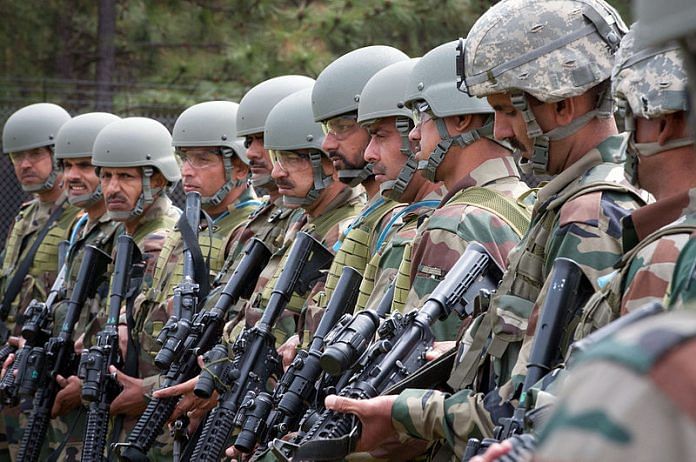As part of Peace Mission 2018, nearly 3,000 troops of eight SCO member states will participate in wargame in Russia.
New Delhi: The armies of India, Pakistan and China are set to rendezvous by the banks of a “beautiful, colourful lake” in Russia next month for a unique wargame.
India has picked a contingent of about 200 soldiers of the 5th battalion of the Rajput regiment and a small complement of the Indian Air Force who will fly to Russia in two transport aircraft for the drills called Peace Mission 2018.
To be held at the Chebarkulsky (meaning “beautiful, colourful lake” in Turkic) training ground on the slopes of the Southern Urals in Russia from 22-29 August, the latest in the ‘Peace Mission’ series could see nearly 3,000 troops of eight Shanghai Cooperation Organisation member states storming an imaginary town whose residents have been held hostage by terrorists.
This could basically be a repeat of the wargame scenario that was executed in a similar drill in Russia in 2014 when India and Pakistan were observers, not full members, of the SCO. The scenario involves the use of tanks and mechanized forces apart from infantry and air elements.
Operating together
This would be the first time the armies of India, Pakistan and China would be involved in a friendly military exercise, along with the other members of the SCO – Russia, Kyrgyzstan, Uzbekistan, Tajikistan, Kazakhstan.
The wargame would be the latest in the series of exercises conducted by the Regional Anti-Terrorism Structure (RATS) of the SCO. India and Pakistan were accorded full member status at the SCO in June last year.
The wargame is being made possible despite differences between India on the one hand and China and Pakistan on the other over Beijing’s One Belt One Road (OBOR) plan, and frequent shooting matches between India and Pakistan along the Line of Control in Jammu and Kashmir.
Despite the stand-off over Jammu and Kashmir, Indian and Pakistani military officials have quietly participated in planning conferences for the exercise in April and May in Tashkent (Uzbekistan), where RATS SCO is headquartered, and in Islamabad, Pakistan.
Indian and Pakistani forces have been operating together over the years under the flag of UN Peacekeeping forces, notably in Congo, where former Indian army chief Gen. Bikram Singh (retired) commanded a division when the former Pakistan army chief, Gen Qamar Jawed Bajwa, headed a brigade.
The Indian and Chinese armies have a series of off-again-on again bilateral exercises named ‘Hand-in-Hand’ since 2007. ‘Hand-in-Hand’ is also wargamed for a counter-terrorist scenario.
India expects greater access to a RATS SCO database of some 3,000 terrorists and more than 100 banned outfits. It would also like outfits such as Jaish-e-Mohammed included in the database but New Delhi is treading the ground delicately lest it disrupt the rubric of the SCO.
Prime Minister Narendra Modi participated in the SCO summit at Qingdao, China, last month. Defence minister Nirmala Sitharaman was also in China in June for a meeting with her SCO counterparts.







Armies of the east coming together is not strange…they will March to Zion through the dried bank of Euphrates
The Tavor family of weapons are best in class and are already being used by our elite forces I.e, Special Forces of Army, Garud of IAF, MARCOS of Navy and CRPF. These weapons are battle proven and were used in the Surgical Strikes too.
An Indian company takes the initiative to bring the technology and start manufacturing it in India. True response to PMs clarion call of Make in India.
Let’s wait and hear the reason from the power corridors for not procuring now and equipping the soldiers with a weapon they want and deserve.
Perhaps we should revisit the notion that it suits China’s best interests to keep India and Pakistan at each other’s throats. China is a pragmatic nation, they have an immense stake in the global economy and integration. The Chinese Ambassado’s suggestion that there should sometimes be an informal summit between the three leaders need not be seen as “ third party intervention in a bilateral dispute “. An option worth exploring, because we have not moved an inch beyond Simla 1972.